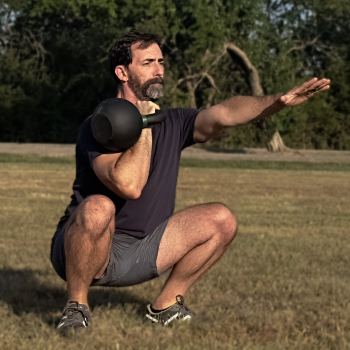

Begin by standing with your feet shoulder-width apart, and the barbell on the floor in front of you.

Control the bar during descent and try not to drop it unless required due to outside factors.Remember to keep your body straight and core tight, and avoid lifting with your arms or rounding your back.
 Exhale and lower the bar following the same movement pattern in reverse. Once the bar has cleared the safety pins, stand up straight with your chest up, shoulders pulled back, and hips fully extended. Be sure to avoid jerking the weight up or rounding your back. Remember, don't use your arms for added strength, and make sure the bar moves in a strictly upwards trajectory and stays close to your body. Keep your feet firmly planted, push through your heels, and lift the bar off the safety pins by extending your hips, flexing your legs, and raising your chest. Take a deep breath into your diaphragm (stomach) and tighten your core before starting the lift. Keep your head neutral and look forward or slightly upward. Maintain a straight spine, keep your chest up, and shoulders back to avoid arching your back. Keep your shoulders pulled back and down and your arms straight. Bend down with a straight back, hinge at the hips, and grab the bar with your hands shoulder-width apart. Keep your toes pointing slightly outward and your shins close to the bar. Stand with your feet shoulder-width apart and the bar centered over your feet. Start by setting the barbell on the safety pins or blocks so that it rests at knee height or slightly above. However, the slight difference is that Romanian deadlifts are a continuous exercise, while a deadlift rack pull has a platform for rest and reset. Many people compare the rack pull vs Romanian deadlift variations due to similar ROM. As a result, the exercise becomes more efficient for the back muscles, including the erector spinae, lats, traps, and rhomboids, while still providing a good workout for the glutes, hamstrings, and forearms. This eliminates the initial portion of the deadlift and results in a shorter range of motion (ROM) that requires less power from the lower body while emphasizing the upper portion of the lift, also known as the “lockout”. While a classic Deadlift starts and ends with the barbell placed on the ground, the deadlift Rack Pull places the barbell on an elevated surface, such as a pair of safety arms or weightlifting blocks.īy starting from a higher position, the rack pull allows the lifter to start at knee height or slightly above. The Rack Pull, also known as the Rack Deadlift, is a variation of the Deadlift exercise with the main difference being the starting position.
Exhale and lower the bar following the same movement pattern in reverse. Once the bar has cleared the safety pins, stand up straight with your chest up, shoulders pulled back, and hips fully extended. Be sure to avoid jerking the weight up or rounding your back. Remember, don't use your arms for added strength, and make sure the bar moves in a strictly upwards trajectory and stays close to your body. Keep your feet firmly planted, push through your heels, and lift the bar off the safety pins by extending your hips, flexing your legs, and raising your chest. Take a deep breath into your diaphragm (stomach) and tighten your core before starting the lift. Keep your head neutral and look forward or slightly upward. Maintain a straight spine, keep your chest up, and shoulders back to avoid arching your back. Keep your shoulders pulled back and down and your arms straight. Bend down with a straight back, hinge at the hips, and grab the bar with your hands shoulder-width apart. Keep your toes pointing slightly outward and your shins close to the bar. Stand with your feet shoulder-width apart and the bar centered over your feet. Start by setting the barbell on the safety pins or blocks so that it rests at knee height or slightly above. However, the slight difference is that Romanian deadlifts are a continuous exercise, while a deadlift rack pull has a platform for rest and reset. Many people compare the rack pull vs Romanian deadlift variations due to similar ROM. As a result, the exercise becomes more efficient for the back muscles, including the erector spinae, lats, traps, and rhomboids, while still providing a good workout for the glutes, hamstrings, and forearms. This eliminates the initial portion of the deadlift and results in a shorter range of motion (ROM) that requires less power from the lower body while emphasizing the upper portion of the lift, also known as the “lockout”. While a classic Deadlift starts and ends with the barbell placed on the ground, the deadlift Rack Pull places the barbell on an elevated surface, such as a pair of safety arms or weightlifting blocks.īy starting from a higher position, the rack pull allows the lifter to start at knee height or slightly above. The Rack Pull, also known as the Rack Deadlift, is a variation of the Deadlift exercise with the main difference being the starting position.







 0 kommentar(er)
0 kommentar(er)
